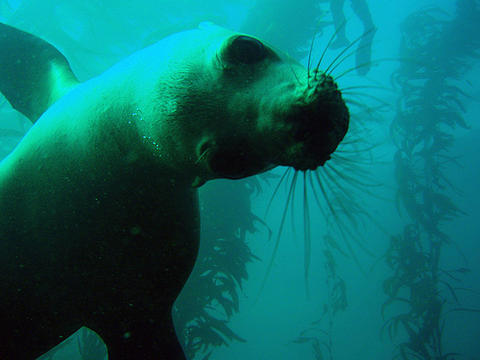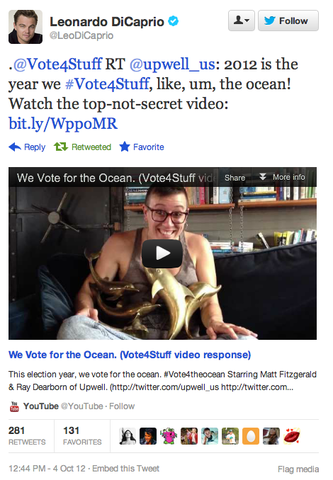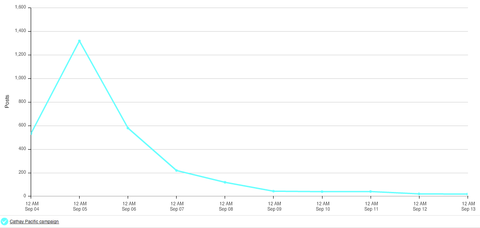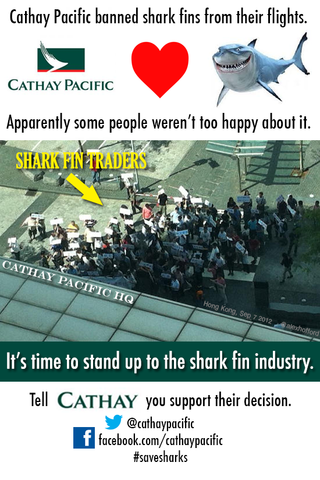Blog Feed
Big Blue Blog Talk: Ocean Acidification, Sustainable Seafood & MPAs

Last week, we shared a list of Big Blue Blogs, which y'all have been sharing and adding to (we'll post an updated list in early January). This week, we're doing a round-up of what the Big Blue Blogs have been saying over the past month, or so about a few of the many ocean issues we track here at Upwell: ocean acidification, sustainable seafood and MPAs.
*OCEAN ACIDIFICATION*
EPOCA's Ocean Acidification blog
Google Earth Tour of a More Acidic World
Oceana. November 5, 2012.
"[The video] above is a good primer on ocean acidification narrated by Dan Laffoley of the International Union for Conservation of Nature (IUCN). The video spans the vulnerable corals of Australia's Great Barrier Reef to the equally vulnerable shellfish industry of the Pacific Northwest, detailing the potential effects of a more acidic ocean."
Corals Call on Fish Bodyguards
Oceana. November 13, 2012
"Coral is under threat worldwide from pollution and ocean acidification from human activity. When corals are stressed, aggressive algae competing for sunlit patches of ocean floor can represent a death blow to coral reefs and the magnificent ecosystems they support. At least one fish, though, isn’t letting the reef go down without a fight."
Catastrophe looms over Antarctica; why you should release your inner psychopath
by Maggie Fazeli Fard on WashingtonPost.com. December 3, 2012
"In 'Lost Antarctica: Adventures in a Disappearing Land,' marine ecologist and Antarctica expert James B. McClintock examines the impact of increasing snowfalls, melting ice and ocean acidification on the continent’s ecology."
*SUSTAINABLE SEAFOOD*
Making Waves Nowhere Near the Ocean
One World One Ocean. November 7, 2012
"Casson Trenor, co-owner of sustainable sushi restaurant, Tataki, spoke about how everyone needs to know the 4 S's in order to decide if fish is sustainable: small, seasonal, silver or shellfish?"
Check out OWOO's Know Your Seafood infographic too.
James Beard Foundation likes our Seafood Watch
Monterey Bay Aquarium, November 12, 2012
Links to a recipe on jamesbeard.org for Tajine of Seafood Chermoula. Holiday dinner idea anyone?
New website lets student farmers connect, share resources
Grist. November 12, 2012
"The food-service company [Bon Appetit Management Company] has a reputation for leading the way on local food, humane meat, farmworker justice, and sustainable seafood. It’s also focused on building and supporting campus food networks."
The Ocean Project Small Grant Winners announced!
The Ocean Project. November 13, 2012
One of the winners was the Arizona-Sonora Desert Museum's Desert-Ocean Connections project. "The project will develop new interactive interpretive stations for the Desert Museum’s 30 Junior Docents, focused on sustainable seafood and desert waters."
Year in PHOTOS: Greenpeace Celebrates a year of global victories thanks to YOU
Greenpeace. December 18, 2012.
"Applauded Safeway for offering sustainably-sourced tuna for their customers (and it’s cheap)!"
*MPAs*
China Blocks Protection of Antartica's Waters: Report
Ocean Views on NatGeo. November 1, 2012.
"Some 1.2 million people asked the 25 member governments of the Commission on the Conservation of Antarctic Marine Living Resources (CCAMLR, composed of 24 countries and the EU) to take action during their annual meeting this week to conserve Antarctic marine ecosystems. Most of them answered this call and were prepared to work on proposals for marine protected areas and reserves in the ecologically important Ross Sea and East Antarctic regions. Ultimately, however, the Antarctic conservation aspirations of the majority of CCAMLR members were reportedly blocked by just a few countries, under the leadership of China."
BlooSee Mobile 2.2 now available for download
BlooSee. November 1, 2012.
"We are also excited to introduce the new infopoint areas feature. Members can now create areas surrounding an infopoint. This is a great tool if the infopoint you are creating is not a single point but a surrounding area. This tool is great for mooring buoys, marine protected areas, and dive spots."
The Weekly Dive. Vol. 44
One World One Ocean. November 5, 2012
"EU's largest marine protected area proposed in Scotland. The Scottish government has proposed to create a package of 'Special Areas of Conservation,' including a 15,694 km sq (9752 mi sq) area at Hatton Bank, off the west coast. [The Scottish Government]"
Sea Turtles: Raja Ampat's Ocean Nomads
Conservation International. November 5, 2012.
"[I]n marine protected areas (MPAs) we are seeing a reduction in the exploitation of turtles."
IUCN: CCMLR members fall short on their obligations and leadership
The Official MPA Blog. November 7, 2012.
"IUCN deeply regrets that no new Marine Protected Areas (MPAs) were declared by the thirty first meeting of the Commission for the Conservation of Antarctic Marine Living Resources (CCAMLR), despite Members’ commitment to do so."
*What stories about ocean acidification, sustainable seafood and MPAs have caught your eye recently?*
Flickr photo credit: Sea Lion: Up Close and Personal by NOAA.
Meet Saray: Coral Reef Lover and Newest Upwell Team Member

Meet Saray Dugas, the newest member of the Upwell team!
Saray loves corals, and is confident that she can identify most of them (you can send her a coral photo at saray AT upwell DOT us).
Originally from Costa Rica, Saray first fell in love with science and biodiversity as a child. Growing up, her heroes were conservationists and biologists who saved tracts of land. Today, her heroes are people who protect the ocean.
Saray's journey as an ocean communicator began while working at Scripps Institution of Oceanography where she developed a desire to communicate science, specifically ocean science, to a wider community of people.
She went on to work in science and communication nonprofits, and has been involved in campaigns for World Oceans Day and the Marine Life Protection Act. Before coming to Upwell, she worked with COMPASS helping scientists to communicate their messages. She also volunteered at the California Academy of Science's design department.
Saray specializes in teaching scientists how to use social media, and how to communicate visually. Her calling in life is to help scientists become better communicators.
You can learn more about Saray on her website, curriesaraydugas.com, and connect with her on Twitter at @SarayDugas.
Big Blue Blogs: 88 Ocean Conservation Blogs

*Jan 15, 2013: We've updated the list to 100+ blogs!
As most of you know, Upwell's mission is to make the ocean more famous online. One way we do that is by sharing ocean-y news in the Tide Report, and by asking you to amplify it.
We can't fit all of the juiciest ocean stories into the Tide Report, which is why we're sharing a list of 88 Big Blue Blogs that cover ocean conservation issues. Our hope is that they will be another source of shareable ocean content for you.
The blogs are in alphabetical order. Please let us know about other big blue blogs we should add to this list by emailing us at tips AT upwell DOT us, sending a tweet (@Upwell.us), leaving a comment, or messaging us on Facebook.
You can also subscribe to the bundle of feeds here.
Big Blue Blogs
- 5 Gyres
- 7 In the Ocean
- A Cotton Thought
- Abandon Fear
- Antarctica Blog, The
- Aquarium of the Pacific Blogs
- Ayana's blog
- Blogfish
- Blogging for a Healthy Gulf
- BlooSee Blog
- Blue Legacy
- Blue Ocean Institute
- Blue Planet Society
- C-log
- Carl Safina
- Cetacean Cousins
- Clean Ocean Action
- Climate Shifts
- Conservation International Blog
- Conservation Law Foundation
- Cool Green Science
- Daily Ocean, The
- Deep Sea News
- EarthEcho International
- Earthjustice
- EDFish
- Fishwise
- Food & Water Watch
- Frank Pope
- Georgia Aquarium
- Good Fish, Good Cook
- Greenpeace
- Grist
- ilovebluesea
- Into the Blue
- IUCN International
- Marine Conservation News
- MarineBio
- Monterey Bay Aquarium
- Mother Nature Network - Oceans
- National Geographic's Ocean Views
- New England Aquarium
- Notes From Sea Level
- NYTimes: Green
- Ocean Acidification
- Ocean Champions
- Ocean Foundation, The
- Ocean Futures Society
- Ocean Portal (Smithsonian)
- Ocean Project, The
- Ocean Wild Things
- Oceana
- Oceans on The Huffington Post
- Oceans on Treehugger
- Oceanwire
- Octopus Chronicles
- Official MPA Blog, The
- Okeanos
- OWOO Blog
- Pacific Environment Blog
- Pacific Voyagers
- PangeaSeed
- Phillips Sustainability Seafood Source
- Plastic Ocean Project, The
- Plastic Pollution Coalition
- Rare Dispatches
- Save Our Seas Foundation
- Save The Bay
- ScienceDaily: Coral Reef News
- ScienceDaily: Oceanography News
- Sea Monster
- Sea Otter Scoop
- Sea Turtle Restoration Project
- Seafish
- Seattle Aquarium
- Southern Fried Science
- Surfrider Foundation
- Switchboard, (NRDC)
- Sylvia Earle Alliance (SEA)
- Team Seagrass
- TNACI Field Notes
- UnderwaterTimes
- Upwell
- WDCS - From the Front Line
- White Shark Conservation Trust
- WildAid
- World Oceans Day
- Ya Like Dags?
Stay tuned for Big Blue Twitter lists!
Flickr photo credit: Wave #1 by James Stark
We Vote 4 the Ocean
In an election cycle, it's even more difficult than usual to break through the noise and make your issue salient, which is why we were psyched when we saw the Vote4Stuff campaign:
"a nonpartisan creation of Leonardo DiCaprio and Tobey Maguire encouraging young people to register to vote and to get to the polls November 6th, wants to hear what you want to vote for, silly or serious." (Rolling Stone)
We choose our campaigns based on what we anticipate will give the highest return, so when this campaign was announced, we jumped on the opportunity to create our own #Vote4theOcean response video overnight.
The next morning, we shared the video with our network via our Tide Report, and with the #vote4stuff campaign via YouTube, Twitter and Facebook. We also included links to conservation campaigns in our video description, and provided pathways to action for viewers.
Within hours, Leonardo DiCaprio shared with his 3.5 million Twitter followers and 3.6 million Facebook fans. We've tracked over 350 social mentions to date, and have gotten over 2000 views of the video (more than any other Vote4Stuff response video).

Our model of quick, responsive campaigning based on trending current events and online conversations is proving to be a successful way to reach new audiences on a daily basis. By de-emphasizing our brand and embracing our informal, internet-savvy voice, we are able to inject ocean conservation messaging into broader conversations.
We are also encouraging more people in the ocean community to make videos of their own. This morning, the nudibranch research lab at the California Academy of Sciences released their own video. Check it out, share it, and make your own #vote4theocean video (and don't forget to tag it with #vote4stuff!)
Attention Lab Update: Giving Cathay Pacific a Collective High-Fin
When Upwell saw the news about Cathay Pacific banning shark fins from their cargo, we thought two things:
- Let’s get some new audiences talking about shark finning.
- This is a great opportunity to do a positively framed campaign, and get people to say “thank you” to Cathay Pacific.
As always, our aim is to increase the number of people talking about shark finning. Before we jump in to what we did and what the results were, first, a graph of our Cathay Pacific & sharks profile in Radian6.

Social mentions September 4 - 13, 2012 of the Cathay Pacific Shark Fin Ban keyword set, built by Upwell.
The first thing that is evident from this graph is that there is a slower drop-off after the initial news bump than we usually see with similar stories. The spike lasted several days - unusual for a news item like this.
Upwell used a two-pronged approach, first helping to spread the news about the ban, then following up the next day with a call for people to thank Cathay Pacific for their decision in our Tide Report and social media channels.
This image spread through our social media channels was shared on hundreds of Tumblrs and in hundreds of tweets. By combining a “shark love” message with an element of urgency (the shark fin traders’ protests), it effectively activated people to voice their support.

Image macro encouraging support of Cathay Pacific’s shark fin ban
We saw over 250 tweets thanking Cathay Pacific, and over 250 posts on the Cathay Pacific Facebook wall (counted by hand) congratulating the airline on a decision well made. The majority of these thank yous aren’t captured in the above graph because they don’t include keywords in our set. It wouldn’t be time efficient to sort through every mention of “thank you” on the internet.
Overall, quite a success in pulling together a quick social media storm in support of sharks.